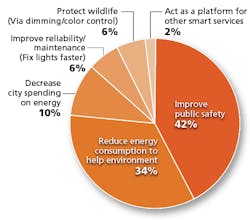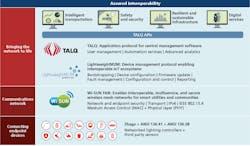Enhancing community safety, accelerating progress toward sustainability goals, and delivering predictable return on investment (ROI) are the key drivers behind the rapid adoption of LED-based solid-state lighting (SSL) systems. Cities from Chicago to Copenhagen to Christchurch are showcasing a variety of social, environmental, and economic benefits realized from upgrading their outdoor lighting networks to intelligent street lights that enable remote connectivity and control by municipalities and consumers (Fig. 1). Although the benefits of LED lighting are myriad, the true power of these systems lies in the underlying technology standards that enable transformation beyond the light, with smarter, digitally-connected services.
As technologies mature, the marketplace of suppliers and service providers becomes increasingly dynamic, requiring careful collaboration on industry standards in order to make interoperable systems — providing the market with more choice and competition while catalyzing innovation. For outdoor lighting, there are three foundational elements of the system: the communication network, endpoint devices, and management software. This article will provide a brief history of smart lighting standards, their maturation and evolution, as well as a preview of emerging standards that will unlock the next generation of smart-city use cases beyond lighting.Foundation of a smart city
Delivering on the promise of digital transformation requires integrating a dynamic ecosystem of hardware, software, and devices in a unified system — one that delivers ubiquitous connectivity and intelligence throughout the city's infrastructure. Every use case will have unique requirements for bandwidth, latency, longevity, and reliability. The ideal lighting solution will enable cities to create a "network of networks" that securely connects multiple network technologies in a unified system (Fig. 3).
Cities and utilities typically begin with a network that can be leveraged to support several follow-on applications, also known as a canopy application — a high-priority use case that justifies a city-wide network deployment. Here, cities and utilities face a common challenge, that is, to monitor and manage distributed critical infrastructure devices to reduce waste. For utilities, this means deploying smart meters equipped with two-way communication to enable remote operations and automate data collection for billing.
Street lighting can consume as much as 50% of a city's annual energy budget, according to Atlantic Monthly's Citylab website1. Thus, cities often start with outdoor lighting to enable remote scheduling of on/off/dimming and utility-grade energy metering. Both use cases involve fixed-location assets that are ubiquitously deployed and require ultrareliable machine-to-machine (M2M) communications. Enter the Wi-SUN (Wireless Smart Utility Networks) Alliance with a technology that was purpose-built for mission-critical applications.
In 2011, a group of technology vendors came together to establish the Wi-SUN Alliance, a global industry coalition whose mission was to develop a technical profile specification, based on well-known industry standards from the IEEE and IETF, to enable multivendor implementations and offer an interoperable Field Area Network (FAN). The Wi-SUN Alliance vision was to utilize license-free radio-frequency (RF) spectrum to deliver reliable and resilient communications for critical infrastructure systems. The technology is based on the IEEE standard 802.15.4g, an RF mesh topology that enables M2M communications between any two devices in the network.
Unlike point-to-multipoint (or "star") networks, one of the key differentiators of mesh networks is that they provide superior coverage (one example of how the topology works can be found with Bluetooth Mesh in indoor environments). In fact, mesh networks become stronger and more resilient as the network density increases, because each endpoint device has multiple redundant connection paths back to the base station. Given the robustness and density of these connections in a dynamic outdoor environment, Wi-SUN FAN is ideally suited for canopy applications such as smart metering and street lighting.
As the adoption of smart grid technology continued to ramp up, Wi-SUN responded to the strong market demand by evolving to incorporate emerging smart-utility use cases. Ultimately, this led the Wi-SUN Alliance to rebrand from wireless smart utility networks to smart ubiquitous networks, thereby reinforcing the technology's position as a leading solution for outdoor industrial IoT (IIoT) networks. In fact, with more than 95 million Wi-SUN-enabled devices deployed to date2, Wi-SUN is the world's most widely-adopted IIoT technology — hence a perfect fit for the foundation of smart lighting and smart city networks.
Often grouped as 5G, the emerging cellular standards — including the high-bandwidth, ultralow latency "small cell" technologies/architecture as well as IIoT-friendly narrowband cellular standards LTE-M (Cat M1 & M2) and NB-IoT (Cat NB1 & NB2) — may provide complementary service offerings and coverage enhancements for specific use cases. Network-of-networks scenarios can be envisioned whereby 5G small cells provide backhaul for the deeper coverage and resiliency of the Wi-SUN RF Mesh FAN. As Low Power Wide Area Network (LPWAN) technologies, Cat M1 and NB-IoT may have the penetration and reach to deliver resilient connectivity for simple data acquisition and asset monitoring applications; however, latency and throughput concerns may rule out critical applications like dynamic lighting or traffic optimization. Having a sophisticated understanding of the various use-case requirements and technology options will be essential to driving pragmatic business decisions for such deployments, and the standards will play a critical role in ensuring interoperability between networks and devices in such a multivendor ecosystem.
Finally, it's important to consider the lifecycle of these connected devices. Critical infrastructure, in particular, has a relatively long lifespan in the field. These devices are often expected to last for more than a decade, so it's important to make sure that the underlying connectivity systems are available throughout this lifecycle. Historically, cellular carriers have upgraded network infrastructure every five to seven years with little to no support for prior generations of connected devices. Such upgrades require costly equipment and maintenance to upgrade legacy systems. Otherwise, these critical infrastructure assets will be left "stranded." An example of a stranded asset would be parking payment kiosks that have embedded 3G cellular modems. With carriers phasing out 3G over the next few years3, these devices will no longer be supported, so cities essentially have to rip and replace these stranded assets. Multigenerational technologies that are backwards-compatible and upgradable over the air provide cities and utilities with the flexibility to deploy their systems over time, with no device left behind.
Connecting endpoint devices
In North America, legacy outdoor lighting hardware is controlled by a simple, 3-pin socket interface networked lighting controller (NLC), as defined by ANSI C136.10. These devices provided simple on/off lighting control needed for basic dusk-to-dawn lighting. Since the first-generation NLCs were required to have the flexibility to work with legacy luminaires that operate at very high voltages and temperatures, the manufacturers needed to incorporate costly electronics to provide a stable, high-quality power supply and surge protection to the fixtures. Likewise, in Europe, legacy outdoor lighting equipment utilized external cabinet controllers, which were costly to manufacture and difficult to service.
The introduction of low-cost LEDs has fundamentally changed the requirements for NLCs. Since LEDs are ultrahigh-efficiency devices that use direct current (DC), LED luminaires operate at significantly lower voltages and temperatures than traditional lighting fixtures. The components within the fixture (e.g., LED drivers) also became smarter and included more advanced (sometimes redundant) electronics. Additionally, since street lights are grid-connected, elevated, and ubiquitous, the light poles can provide even greater value when used as physical mounting infrastructure for IIoT networks to connect other smart-city assets. As cities take a more holistic view of their lighting modernization initiatives, the ratio of hardware cost relative to installation and labor is becoming less significant. Therefore, many cities are taking a strategic view to leverage these upgrades and lay the groundwork for future applications.
Recognizing the opportunity to utilize outdoor lighting systems to enable more advanced smart-city use cases, the market responded by introducing a more robust standard, ANSI C136.41, which specifies a 7-pin interface that provides significantly enhanced capabilities. Two of the seven pins were designated to enable the advanced dimming features of the LED fixture (raise/ lower light levels), providing lighting operators with more flexibility to manage lighting output to optimize for efficiency, safety, and quality of service. The other two pins (6 and 7) were not assigned to specific functionality, but recent movement within the standards committees has identified several smart-city use cases that involve connecting sensors to this interface.
Layering on multipurpose communications further enhanced the ROI for smart lighting systems by providing real-time visibility to monitor and control any connected smart-city asset. As the technology continued to mature, the adoption rate accelerated, with many of the world's leading cities completing full-scale rollouts of deployments. This presented a new set of challenges: With many deployments exceeding hundreds of thousands, or even millions, of connected devices, these high-volume deployments introduced greater risk of human error. For example, maintaining accurate asset information often required manual data entry in multiple back-office systems. Automated installation and commissioning promised to correct many of these issues but required additional enhancements to provide more data that would improve asset management.
With an eye toward the future, the upcoming ANSI 137.4 standard incorporates a digital addressable lighting interface (DALI) — a standard created by the Digital Illumination Interface Alliance — to provide a common framework for collecting luminaire-specific data for asset management (see a prior article for background on DALI and DALI-2). This enhanced capability allows manufacturers to program asset data about each light point directly into the LED driver. When combined with a smart lighting controller, this feature automates the collection of key information (e.g., manufacturer make/model, serial number, wattage) that enables lighting operators to monitor and manage their data sets accurately and efficiently.
While the NEMA 7-pin twist-lock receptacle has been the most widely-adopted configuration for lighting controllers to date (outside of Europe and some of Asia), the technology has largely been the result of a series of incremental improvements on a solution that was initially created to control legacy, high-voltage, AC-powered lighting systems, establishing a perfect opportunity for new technology to disrupt the outdoor lighting industry.
In Europe and parts of Asia, the new Zhaga Book 18 standard (and new North American ANSI 136.58 standard) for smart lighting controllers addresses the industry's fundamental need to have a lighting controller that is optimized for low-voltage, DC-powered LED lighting systems. By designing the controllers specifically for DC luminaires, Zhaga lighting controllers can eliminate many of the cost, durability, and volume constraints that device makers had to consider for NEMA-based designs. Zhaga controllers are also designed to maximize interoperability of lighting components across a diverse range of suppliers, recognizing the varied needs of smart cities and the market demand for flexible and upgradable solutions. Editor's note: An interoperability demonstration recently took place at the LED professional Symposium.
In addition to the primary role of connecting and controlling LED luminaires, lighting controllers can serve as a platform for enabling other connected smart-city assets. Zhaga-compliant controllers feature four connection points: the 24V DC power supply, two DALI connectors for asset management of the luminaire, and a general-purpose digital interface used for extension modules that provide sensing and communication capabilities.
Including an extension module in the Zhaga controller design transforms the lighting controller into an extensible platform for advanced smart-city sensors. The built-in 24V DC power supply also addresses some of the challenges of high-voltage, high-current legacy systems. Offering direct access to DC power makes it possible to eliminate redundant hardware for surge protection and power conditioning in both the LED driver and lighting controller, which dramatically reduces the cost and complexity of extension modules. This approach is analogous to the way the universal serial bus (USB) interface simplified the ecosystem of PC and mobile accessories. Ultimately, this streamlined approach will open a wide range of possibilities for new non-lighting use cases.
For instance, the extension module could be used to add a radar sensor for measuring traffic throughput, providing lighting operators with real-time data to enable dynamic dimming programs to match traffic patterns. Alternatively, the extension module could be used to power a variety of cellular or LPWAN network gateways, thus creating a network of networks to provide cost-effective connectivity to a wide range of city assets.
Bringing the network to life
Now that we have established the network foundation and the physical-mechanical interfaces to connect smart city assets, the next challenge is how to bring these devices to life. Specifically, how are these devices deployed, configured, and managed on a smart city network?
Since 2002, the Open Mobile Alliance (OMA) has defined a standard device-management framework to enable interoperable mobile devices across multiple network technologies and carriers. While the OMA has provided a framework to guide future IoT implementations, the challenge of managing heterogeneous and often constrained IoT devices requires a different approach.
To address these challenges, leading equipment vendors and network operators collaborated to create a new protocol, LightweightM2M (LWM2M), which facilitates the full lifecycle management of connected devices, starting from the manufacturing facility, to ensuring secure communications, to monitoring end of life. The vision was to provide a framework that would enable an ecosystem of IoT-connected devices to ensure seamless interoperability across multiple device vendors, carriers, and connectivity media.
LWM2M provides a standard framework for technology vendors to create solutions that can securely connect and interoperate on a smart city network. This allows network operators, regardless of the connectivity media, to enable an ecosystem of suppliers. For technology vendors, standardizing device management protocol minimizes the cost and complexity of developing a solution that will work across a range of networks, which dramatically accelerates time to market.
While the preceding section covered many of the technical barriers to enabling an interoperable smart-city ecosystem, lighting standards also play a vital role in enabling cities to make use of these solutions in their day-to-day operations. Specifically, how are these standards making data available to end-user applications?
Lighting management software is the primary driver behind this movement. The market recognized that cities require flexibility and choice across all layers of the smart lighting system. Several leading outdoor lighting suppliers established the TALQ Consortium in order to create a globally recognized standard for central management software (CMS) interfaces to configure, command, control, and monitor heterogeneous outdoor lighting networks. It was a major step for manufacturers to take so that cities would not be locked in to proprietary systems.
In 2017, the TALQ Consortium widened its scope to foster compatibility among various smart-city applications. Now the TALQ Smart City Protocol is a specification for information exchange, suitable for implementation in software and hardware products to enable interoperability between CMS and Outdoor Device Networks (ODNs) from different vendors. The benefits are a flexible data model that is applicable to a wide range of sectors and many different use cases, such as outdoor lighting control; waste collection; parking space detection; environmental data collection; energy management; and others.
While the first generation of TALQ incorporated many of the same device-management capabilities that had been addressed by LWM2M, the expanded scope of the TALQ protocol requires further alignment.
Adopting device management frameworks such as LWM2M will ensure that CMS standards such as TALQ will continue to support interoperability with the broader ecosystem of IoT solution providers.
With lighting modernization (i.e., LED upgrade with smart lighting controls) as a leading canopy application, cities started to require greater interoperability by including TALQ compatibility as a request into their tenders. As a result, more and more vendors are starting to integrate the TALQ Smart City Protocol into their smart lighting and smart city products.
Today, lighting operators are continuing to push the envelope of smart city innovation by incorporating advanced sensors to help optimize lighting conditions, enhance energy savings, and improve safety (Fig. 4). For example, many cities are experimenting with dynamic lighting controls that utilize advanced motion sensors or smart cameras to adjust lighting levels based on local traffic conditions. Incorporating these devices in unified CMS is eased if all the components are certified as TALQ-compliant.
The next frontier of smart-city innovation
With proven technology and a clear business case, intelligent outdoor lighting systems will play a vital role in enabling the city of the future. In fact, adoption is expected to accelerate over the next decade4, thus reinforcing lighting as an innovation catalyst for smart cities. The ecosystem of solution providers will mature and diversify across all layers of the solutions suite: the network, endpoint devices, and value-added applications.
As we look toward the future, the next challenge will be how to tap into this ecosystem of interoperable solutions to unlock the next set of smart city use cases. Innovation in technology standards will be essential to achieving this vision.
What matters most to cities is not the technology that they deploy, but that these solutions can create a meaningful improvement in the economic, environmental, and social outcomes that cities can deliver for their residents. Living in a truly smart city should be a seamless experience where intelligent devices provide visibility to real-time conditions and services. For example, smart cameras can be utilized to dynamically optimize traffic signals and/or direct drivers to available parking spots. This will require distributed intelligence to analyze data as well as ultralow-latency M2M communications to eliminate the need to communicate with centralized back-office systems.
Standards will play a critical role in delivering on this promise through lighting and networked infrastructure. It's time to start looking at building citywide IoT networks as a mission, with the proper supporting knowledge base, rather than a challenge.
REFERENCES
1. N. Berg, "The Secret Energy Drain on Cities: Streetlights," Citylab website (Apr. 30, 2012).
2. Navigant Research, "Global AMI Tracker 2Q19, Smart Meter Projects: Project Tracking, Regional Analysis, and Market Shares."
3. Telit post, "The 3G network sunset and its implications for IoT," RCR Wireless News (Apr. 10, 2019).
4. Northeast Group, LLC, "Global Smart Street Lighting & Smart Cities: Market Forecast (2019-2028), Volume V."
Get to know our expert
DAN EVANS is senior director of smart city product management at Itron. He is responsible for defining the product roadmap for the Smart Cities and Smart Lighting business unit. Evans joined Itron through its acquisition of Silver Spring Networks. He joined Silver Spring in 2007 and was instrumental in building the product, processes, and team who took Silver Spring Networks' installed base from 5000 units when he joined to more than 27 million today. Evans has gained more than 30 years of experience in the networking space in a variety of roles at SkyPilot Networks, Excite@Home, and NASA. He has a bachelor of science degree in computer science from California's San Jose State University.
COMING NEXT ISSUE
Optics manufacturers hone offerings
We often make the point that optics and lenses can make or break the quality of experience with finished solid-state lighting (SSL) products, whether in general illumination, architectural lighting, or even automotive applications. Optical components have heavy expectations placed upon them, such as diffusing light, eliminating glare, delivering appropriate beam distribution, and in some cases, even enabling customizable beam angles. As with other enabling technologies such as LED drivers (see our recent feature at http://bit.ly/2mV6qWG), application needs are often pushing the boundaries of optical design. In the November/December issue, our Focus On Optics will take stock of the most recent product developments in optics, lenses, diffusers, and so on, and will explore how engineers have leveraged specific properties to help OEMs optimize their end products for a range of applications.









